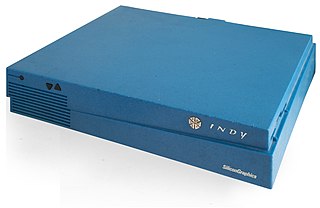
Silicon Graphics, Inc. was an American high-performance computing manufacturer, producing computer hardware and software. Founded in Mountain View, California in November 1981 by Jim Clark, its initial market was 3D graphics computer workstations, but its products, strategies and market positions developed significantly over time.

A workstation is a special computer designed for technical or scientific applications. Intended primarily to be used by a single user, they are commonly connected to a local area network and run multi-user operating systems. The term workstation has been used loosely to refer to everything from a mainframe computer terminal to a PC connected to a network, but the most common form refers to the class of hardware offered by several current and defunct companies such as Sun Microsystems, Silicon Graphics, Apollo Computer, DEC, HP, NeXT, and IBM which powered the 3D computer graphics revolution of the late 1990s.

The Weather Channel (TWC) is an American pay television channel owned by Weather Group, LLC, a subsidiary of Allen Media Group. The channel's headquarters are in Atlanta, Georgia. Launched on May 2, 1982, the channel broadcasts weather forecasts and weather-related news and analysis, along with documentaries and entertainment programming related to weather. A sister network, Weatherscan, is a digital cable and satellite service that offers 24-hour automated local forecasts and radar imagery. The Weather Channel also produces outsourced weathercasts, notably for RFD-TV.

The Indy, code-named "Guinness", is a low-end multimedia workstation introduced on July 12, 1993. Silicon Graphics Incorporated (SGI) developed, manufactured, and marketed Indy as the lowest end of its product line, for computer-aided design (CAD), desktop publishing, and multimedia markets. It competed with Intel x86 computers, and with Windows and Macintosh, including using their files and running their applications via software emulation. It is the first computer to come standard with a video camera, called IndyCam. Indy was repackaged as a server model called Challenge S. Indy was discontinued on June 30, 1997 and support ended on December 31, 2011.
The Weather Network (TWN) is a Canadian English-language weather information specialty channel available in Canada, the United States and the United Kingdom. It delivers weather information on television, digital platforms and TV apps. The network also operates counterpart brands including MétéoMédia; Canadian, Eltiempo Spain, Wetter Plus Germany, and Clima Latin America.

The Indigo, introduced as the IRIS Indigo, is a line of workstation computers developed and manufactured by Silicon Graphics, Inc. (SGI). SGI first announced the system in July 1991.
James D. Cantore is an American meteorologist. He is best known as an on-air personality for The Weather Channel.

Storm Stories is an American non-fiction television series that airs on The Weather Channel (TWC) and Zone Reality. It is hosted and narrated by meteorologist and storm tracker Jim Cantore. Storm Stories showcases various types of severe weather, such as tornadoes, hurricanes, and blizzards. Each episode features a famous severe storm, and survivors of it sharing their experiences. The program also features footage of the storm if it is available, but typically a re-enactment is used instead. The video of the storm is often shown while the survivors offer their accounts of it. Often, TWC would air a special week dedicated to one specific type of storm.
WeatherStar is the technology used by American cable and satellite television network The Weather Channel (TWC) to generate its local forecast segments—branded as Local on the 8s (LOT8s) since 2002 and previously from 1996 to 1998—on cable and IPTV systems nationwide. The hardware takes the form of a computerized unit installed at a cable system's headend. It receives, generates, and inserts local forecast and other weather information, including weather advisories and warnings, into TWC's national programming.
Weatherscan is a moribund American digital cable and satellite television network owned by Allen Media Group. A spinoff of The Weather Channel, Weatherscan features uninterrupted local weather information in graphical format on a continuous loop that is generated by an IntelliStar unit installed at the cable provider's headend; unlike The Weather Channel, Weatherscan does not feature on-air talent of any kind.

The IRIS Crimson is a Silicon Graphics (SGI) computer released in 1992. It is the world's first 64-bit workstation.

Local on the 8s is a program segment that airs on the American network The Weather Channel. It provides viewers with information on current and forecasted weather conditions for their respective area; a version of this segment is also available on the channel's national satellite feed that features forecasts for each region of the United States. The name comes from the timing of the segment, as airs at timeslots that end in "8" ; because of this manner of scheduling, the forecast segments air on the channel in ten-minute intervals. From 2006-2013, each forecast segment had usually been preceded by a promo for one of The Weather Channel's programs or services, leading into the segment with the announcer stating "And now, your Local on the 8s". On November 12, 2013, the promo segment was replaced by an intro that was built into the Local on the 8s segment. As of April 2018, the segment airs at approximately :18 past each hour. It also usually airs at approximately :48 past each hour during live Weather Channel broadcasts.

AlphaStation is the name given to a series of computer workstations, produced from 1994 onwards by Digital Equipment Corporation, and later by Compaq and HP. As the name suggests, the AlphaStations were based on the DEC Alpha 64-bit microprocessor. Supported operating systems for AlphaStations comprise Tru64 UNIX, OpenVMS and Windows NT. Most of these workstations can also run various versions of Linux and BSD operating systems.
In broadcasting, local insertion is the act or capability of a broadcast television station, radio station or cable system to insert or replace part of a network feed with content unique to the local station or system. Most often this is a station identification, but is also commonly used for television or radio advertisements, or a weather or traffic report. A digital on-screen graphic, commonly a translucent watermark, may also be keyed (superimposed) with a television station ID over the network feed using a character generator using genlock. In cases where individual broadcast stations carry programs separate from those shown on the main network, this is known as regional variation or an opt-out.
PMX refers to the technology developed by Pelmorex to generate local weather information on The Weather Network. PMX consists of computers, typically installed at a cable headend, that takes data fed to it and packages it for broadcast. Unlike the Weather Star systems, it does not generate full graphical or video segments, rather the information is super-imposed over the main video feed. There are 4 different PMX units: PMX-1500, PMX-3200, PMX-NG and PMX-XD.
The Weather Channel is an American basic cable and satellite television channel owned by Byron Allen's Entertainment Studios that focuses on national and international weather information; although in recent years, the channel has also incorporated entertainment-based programs related to weather on its schedule. This article details the history of the channel, which dates back its founding to around 1980.

The Weather Channel Latin America is a website which formerly served as a cable and satellite channel based on the American cable and satellite television network, The Weather Channel. The channel was launched in 1996, mainly in Mexico, Colombia, and Argentina, before going on to launch a Portuguese language version for Brazil in 1998. The channel operated from Atlanta, with later sales offices initiated in several Latin American countries, until December 20, 2002, when the network closed the channel to avoid cost cuts at its American operations.

The Weather Cast was a short-lived television channel seen exclusively on Dish Network. The channel was devoted solely to weather forecasts from across the United States, and was a direct competitor to The Weather Channel. The service was owned by Minneapolis-based WeatherNation The channel was operated for only four days.

Verizon Fios is a bundled internet access, telephone, and television service provided by Verizon Communications that operates over a fiber optical network within the United States.

Local Now is an American over-the-top internet television service owned by The Weather Group, LLC, a subsidiary of Entertainment Studios. A spinoff of The Weather Channel, Local Now primarily provides a cyclic playlist of weather, news, sports, entertainment and lifestyle segments, incorporating localized content through feeds geared to a user-specified area.













